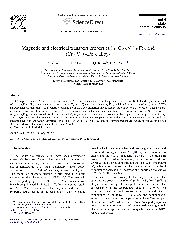摘要
DC magnetization M(T) and electrical resistivity rho(T) have been studied in the temperature range of 4-300 K for (CrggV(1))(95)Fe-5 and (CrggV(1))(75)Fe-25 alloys. A minimum is observed near T-N in rho(T) curve for (CrggV(1))(95)Fe-5, which indicates the spin-density wave (SDW) antiferromagnetic transition. The progressive opening up of the SDW antiferromaunetic energy gap can be well described by a temperature-dependent energy gap function as 2 Delta alpha root T-N - T. A paramagnetic-ferromagnetic transition is confirmed near T-C in M(T) curve for (CrggV(1))(75)Fe-25, but no anomaly is observed around T-C in rho(T) curve that would be covered up by magnetic cluster-dependent scattering. The analyses indicated the magnetic clusters start to form at relatively high temperature above the transition temperature. T-N and the SDW antiferromagnetism are rapidly depressed for Fe-poor (Cr99V1)(95)Fe-5 while T-C and the ferromagnetism are rapidly increased for Fe-rich (Cr99V(1))(75)Fe-25 by the substitution of light doping V for Cr.
